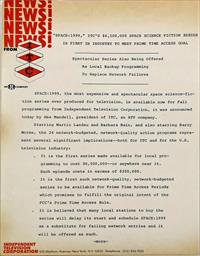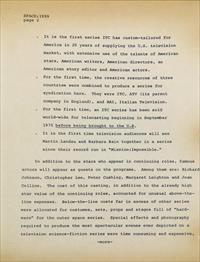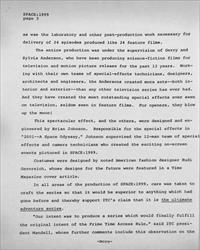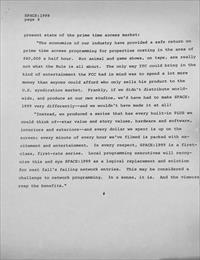Publicity
News! From ITC
This 4 page document is probably from early to mid 1975, promoting the series to US stations for the autumn schedules.




"SPACE:1999", ITC'S $6,500,000 SPACE SCIENCE FICTION SERIES
IS FIRST IN INDUSTRY TO MEET PRIME TIME ACCESS GOAL
Spectacular Series Also Being Offered
As Local Backup Programming
To Replace Network Failures
SPACE:1999, the most expensive and spectacular space science-fiction series ever produced for television, is available now for Fall programming from Independent Television Corporation, it was announced today by Abe Mande11, president of ITC, an ATV company.
Starring Martin Landau and Barbara Bain, and also starring Barry Morse, the 24 network-budgeted, network-quality action programs represent several significant implications for ITC and for the U.S. television industry:
- more -
SPACE:1999
page 2
In addition to the stars who appear in continuing roles, famous actors will appear as guests on the programs. Among them are: Richard Johnson, Christopher Lee, Peter Cushing, Margaret Leighton and Joan Collins. The cost of this casting, in addition to the already high star value of the continuing roles, accounted for unusual above-the- line expenses. Below-the-line costs far in excess of other series were allocated for costumes, sets, props and stages full of "hard- ware" for the outer space series. Special effects and photography required to produce the most spectacular scenes ever depicted on a television science-fiction series were time consuming and expensive,
- more -
SPACE:1999
page 3
as was the laboratory and other post-production work necessary for delivery of 24 episodes produced like 24 feature films.
The entire production wag under the supervision of Gerry and Sylvia Anderson, who have been producing science-fiction filming for television and motion picture release for the page 12 years. Working with their own teams of special-effects technicians, designers, architects and engineers, the Andersons created more sets - both interior and exterior - than any other television series hag ever had. And they have created the most outstanding special effects ever seen on television, seldom seen in feature films. For openers, they blow up the moon!
This spectacular effect, and the others, were designed and engineered by Brian Johnson. Responsible for the special effects in 2001- A Space Odyssey, Johnson supervised the 12-man team of special effects and camera technicians who created the exciting on-screen events pictured in SPACE:1999.
Costumes were designed by noted American fashion designer Rudi Gernreich, whose designs for the future were featured in a Time Magazine cover article.
In all areas of the production of SPACE:1999, care was taken to craft the series so that it would be superior to anything which had gone before and thereby support ITC's claim that it is the ultimate adventure series.
"Our intent was to produce a series which would finally fulfil the original intent of the Prime Time Access Rule," said ITC president Mandell, whose further comments include this observation on the
- more -
SPACE:1999
page 4
present state of the prime time access market:
"The economics of our industry have provided a safe return on prime time access programming for properties costing in the area of $40,000 a half hour. But animal and game shows, on tape, are really not what the Rule is all about. The only way ITC could bring in the kind of entertainment the FCC had in mind was to spend a lot more money than anyone could afford who only sells his product to the U.S. syndication market. Frankly, if we didn't distribute world- wide, and produce at our own studios, we'd have had to make SPACE:1999 very differently - we wouldn't have made it at all!
"Instead, we produced a series that has every built-in PLUS we could think of - star value and story values, hardware and software, interiors and exteriors--and every dollar we spent is up on the screen; every minute of every hour we've filmed is packed with excitement and entertainment. In every respect, SPACE:1999 is a first-class, first-rate series. Local programming executives will recognize this and eye SPACE:1999 as a logical replacement and solution for next fall's failing network entries. This may be considered a challenge to network programming. In a sense, it is. And the viewers reap the benefits."